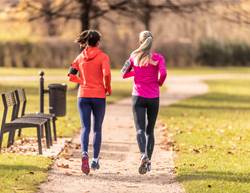I’ll admit it. I’m kind of old-school when it comes to stretching. I know the supposed benefits of stretching are a bit over-hyped: Research suggests stretching before a workout probably doesn’t prevent injury like we were always taught in P.E. class. And as far as post-workout recovery goes, foam rolling is considered a more effective way to prevent muscle soreness.
But I still love a good, static stretch after a workout. And I’d recently heard that bridges could help with everything from preventing knee pain to improving posture, so I figured I’d try adding them into my post-workout cool-down for a few weeks and see if the hype was true.
Of course, before I could start, I had to decide which type of bridge to do. There are two basic options:
- Half bridge (“bridge pose”). Lie on your back with your knees bent and feet flat on the floor. Keeping your shoulders on the floor, slowly raise your hips towards the ceiling as far as you can. (If you don’t stretch your back often, this is a good place to start.)
- Full bridge ("wheel pose”). Lie on your back with knees bent and feet flat on the floor. Bring your hands to your shoulders—palms up, like you’re carrying tiny pizza trays (can you tell I used to teach preschool gymnastics?)—and place them on the floor next to your ears, with your fingertips pointing toward your toes. Lift your hips off the ground, then push up with your shoulders and legs at the same time.
I originally planned to do three full bridges, for 10 to 15 seconds each, after every workout. (Normally I’d ease into a challenge like this, but I’ve been doing yoga and gymnastics for 20 years, so back flexibility is one of my strong suits.) But there were definitely a few times—usually after doing too many shoulder presses at a circuit training class—that my tired jelly-arms just didn’t want to hold me up. When that happened, I subbed in a half bridge instead. Hey, a bridge is a bridge, right? Here’s what happened when I made them a regular part of my post-workout stretch.
1. I realised I take my back for granted.
I work my arms, my legs, my abs and my butt at the gym, but I can’t remember the last time I actively tried to strengthen my back muscles. When I do core moves, let’s be honest: I’m usually focusing squarely on ab exercises. But considering 80% of people will deal with back pain at some point, I should probably start paying attention to the other part of my core.
2. My flexibility improved.
I consider myself pretty flexible, but over the past three weeks, I’ve been able to inch my hands and feet closer to each other when I’m upside down and arch my back a bit more. It’s a small difference, but a good reminder that flexibility is a use-it-or-lose-it thing—and as I approach 40, I really shouldn’t slack on stretching.
3. I felt less slouchy.
As a writer, I spend a good part of my days hunched over my computer. It's not the best health habit, I know, but it turns out back bends are one of the exercises that can work wonders if you sit at a desk all day because they help stabilise your back muscles. And I did find myself sitting up a little straighter at my desk instead of slowly melting into the keyboard.
4. My legs felt stronger.
Bridges are one of the best exercises you can do for your butt, and you end up engaging your legs and core, too. Toward the end of the challenge I started to notice exercises that rely on my hamstrings—like squats and running—felt a teensy bit easier.
5. I got six-pack abs.
Okay, so that didn’t happen. But this challenge made me aware that I need to focus on my core a bit more than I have been. And when it comes down to it, bridges are yoga poses—and doing them after my workouts forced me to take a minute or two to relax, breathe, and get a new (upside-down!) perspective on things.



.jpg&h=90&w=90&c=1&s=1)





